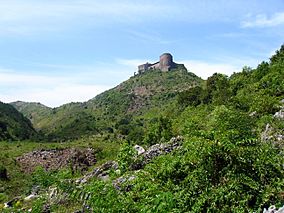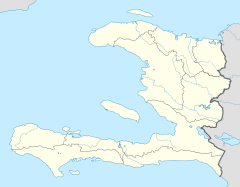National History Park facts for kids
Quick facts for kids National History Park |
|
|---|---|
| Pak nasyonal istorik - Sitadèl, Sansousi, Ramye Parc national historique Citadelle Sans-Souci Ramiers |
|
|
IUCN Category IV (Habitat/Species Management Area)
|
|
 |
|
| Location | Haiti |
| Area | 25.28 km2 (9.76 sq mi) |
| Established | 1968 |
The National History Park is a special place in Haiti. It was created in 1968 to protect important historical sites. This amazing park is located in a town called Milot. In 1982, UNESCO named it a World Heritage Site. This means it's considered very important for everyone in the world to protect.
The park is mostly made up of three incredible ruins. These are the Sans-Souci Palace, the huge Citadelle Laferrière, and the buildings at Ramiers. They all tell a story of Haiti's past.
Discovering Haiti's National History Park
Imagine stepping back in time! The National History Park lets you explore the remains of grand buildings. These structures were built by the first free Black nation in the Americas. They show the strength and spirit of the Haitian people.
What Makes This Park Special?
This park is unique because it combines nature with history. You can see beautiful landscapes while learning about Haiti's fight for freedom. It's a place where history comes alive.
A UNESCO World Heritage Site
Being a UNESCO World Heritage Site is a big deal. It means the park has outstanding universal value. It's like a global treasure that needs to be preserved. This recognition helps protect the sites for future generations.
The Mighty Citadelle Laferrière
The Citadelle Laferrière is a giant fortress built on top of a mountain. It's one of the largest fortresses in the Americas. King Henri Christophe ordered its construction after Haiti gained independence. He wanted to protect Haiti from future attacks.
Building a Mountain Fortress
Building the Citadelle was a huge task. Thousands of workers spent years carrying stones up the mountain. It was designed to hold cannons and supplies for a large army. From its walls, you can see amazing views of the surrounding area. It truly looks like an eagle's nest.
Exploring the Citadelle
When you visit, you can walk through its massive walls and tunnels. You'll see where soldiers lived and where cannons were placed. It's a powerful reminder of Haiti's determination to stay free.
The Royal Sans-Souci Palace
Below the Citadelle, you'll find the ruins of the Sans-Souci Palace. This was the royal residence of King Henri Christophe. It was once a magnificent palace, known for its beauty and luxury. Its name, "Sans-Souci," means "without worries" in French.
Life in the Palace
The palace had gardens, artificial pools, and fountains. It was a center for royal ceremonies and celebrations. Though now in ruins, you can still imagine its former glory. It shows how grand life was for the king.
A Symbol of Haitian Power
The Sans-Souci Palace was a symbol of Haiti's new power. It showed the world that Haiti was a strong and independent nation. It stood as a testament to the country's ability to build great things.
Ramiers: A Hidden Gem
The third part of the park includes the buildings at Ramiers. These are smaller structures that were also part of the defense system. They helped protect the palace and the fortress.
Connecting the Sites
Ramiers connects the Citadelle and the Sans-Souci Palace. It shows how all these sites worked together. They formed a complete defense system for the new nation.
Images for kids
See also
 In Spanish: Parque nacional Histórico (Haití) para niños
In Spanish: Parque nacional Histórico (Haití) para niños
- List of national parks of Haiti










